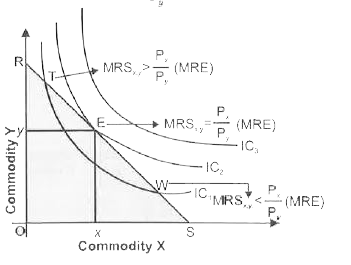Why is the consumer in equilibrium when he buys only that combination of the two goods that is shown at the point of tangency of the budget line with an indifference curve ? Explain .
(i) To define consumer equilibrium, we use Interference Curve map and the budget line .
Two conditions for consumer Equilibrium
(a) Necessary Condition
Marginal Rate of Substitution = Market Rate of Exchange
Or ,
( Market Rate of Exchange ) MRE
Or
If ,
At point T in figure
It means the consumer.s willingness to pay for commodity X is higher than what makes values for commodity X. So, the consumer should buy more of X and less of Y to get MRS

If , At point W in figure,
It means the consumer willingness to pay for commodity X is lesser than what market value for commodity X ,So, consumer should buy less of X and more Y to get MRS =
(b) Sufficient Condition
Diminishing (Convex) at a point of equilibrium i.e., when
(ii) The consumer will reach equilibrium when the budget line is tangential to the higher possible Indifference Curve, i.e. ., where necessary and sufficient condition satisfy . In the above diagram , the consumer will reach equilibrium at point E where budget line RS is tangential to the higher possible
(iii) The consumer cannot move to Indifference Curve , i.e. ., as this is beyond this money income.
(iv) Even on all the other points except E are beyond his means .
(v) Hence , at point E, the consumer is in equilibrium where his satisfaction maximizes, given his income and prices of goods X and Y . In equilibrium at E , the slope of Budget line = the slope of Indifference Curve. Therefore is equal to the ratio of the price bof two goods .
Topper's Solved these Questions
- CONSUMER EQUILIBRIUM Book:FULL MARKSChapter:CONSUMER EQUILIBRIUM Exercise:MORE QUESTIONS SOLVED (VI. HIGHER ORDER THINKING SKILLS (HOTS))
Explore 9 Videos
- CONSUMER EQUILIBRIUM Book:FULL MARKSChapter:CONSUMER EQUILIBRIUM Exercise:MORE QUESTIONS SOLVED (VII. VALUE BASED QUESTIONS)
Explore 1 Video
- CONSUMER EQUILIBRIUM Book:FULL MARKSChapter:CONSUMER EQUILIBRIUM Exercise:MORE QUESTIONS SOLVED (IV. TRUE OR FALSE) (Giving reasons, state whether the following statements are true or false. )
Explore 12 Videos
- COSTBook:FULL MARKSChapter:COSTExercise:NCERT TEXTBOOK QUESTIONS SOLVED
Explore 137 Videos
Similar Questions
A consumer consumes only two goods. Why is the consumer said to be in equilibrium when he buy only that combination of the two goods Which lies at that point on the Indifference curve where the budget line is tangent to the indifference curve? Explain. Use diagram.
View SolutionA consumer consumes only two goods X and Y both priced at Rs 3 per unit. If the consumer choose a combination of these two goods with Marginal Rate of Substitution equal to 3, is the consumer in equilibrium ? Give reason. What will a rational consumer do in this situation ? Explain ltrbgt OR
State and explain three properties of indifference curves.
View Solution
Knowledge Check
The consumer is in equilibrium at a point where the budget line -
AIs above an indifference curve.BIs below indifference curve.CIs tangent to an indifference curve.DCuts an indifference curve.The consumer is in equilibrium at a point where the budget line:
AIs above an indifference curveBIs below an indifference curveCIs tangent to an indifference curve ?DCuts an indifference curve.A consumer consumes only two goods. If price of one of the good falls, the indifference curve:
AShifts leftwardBShifts rightwardCcan shift both leftward and rightwardDDoes not shift
For a consumer to be in equilibrium why must marginal rate of substitution be equal to the ratio of prices of the two goods?
View SolutionIdentify which of the following is not true for the Indifference Curves. Give valid reasons for choice of your answer.
(a) Lower indifference curve represents lower level of satisfaction
(b) Two regular convex to origin indifference curves can intersect each other.
(c) Indifference curve must be convex to origin at the point of tangency with the budget line at the consumer's equilibrium. ltbr> (d) Indifference curves are drawn under the ordinal approach to consumer equilibrium
View SolutionA consumer consumer only two goods. For the consumer to be in equilibrium, why must Marginal Rate of Substitution between the two goods must be equal to the ratio of prices of these two goods ? Is it enough to ensure equilibrium ?
View SolutionA consumer is in equilibrium where indifference curve equals budget line ?
View SolutionAn Indifference Curve represents all those combinations of two goods which give:
View Solution
